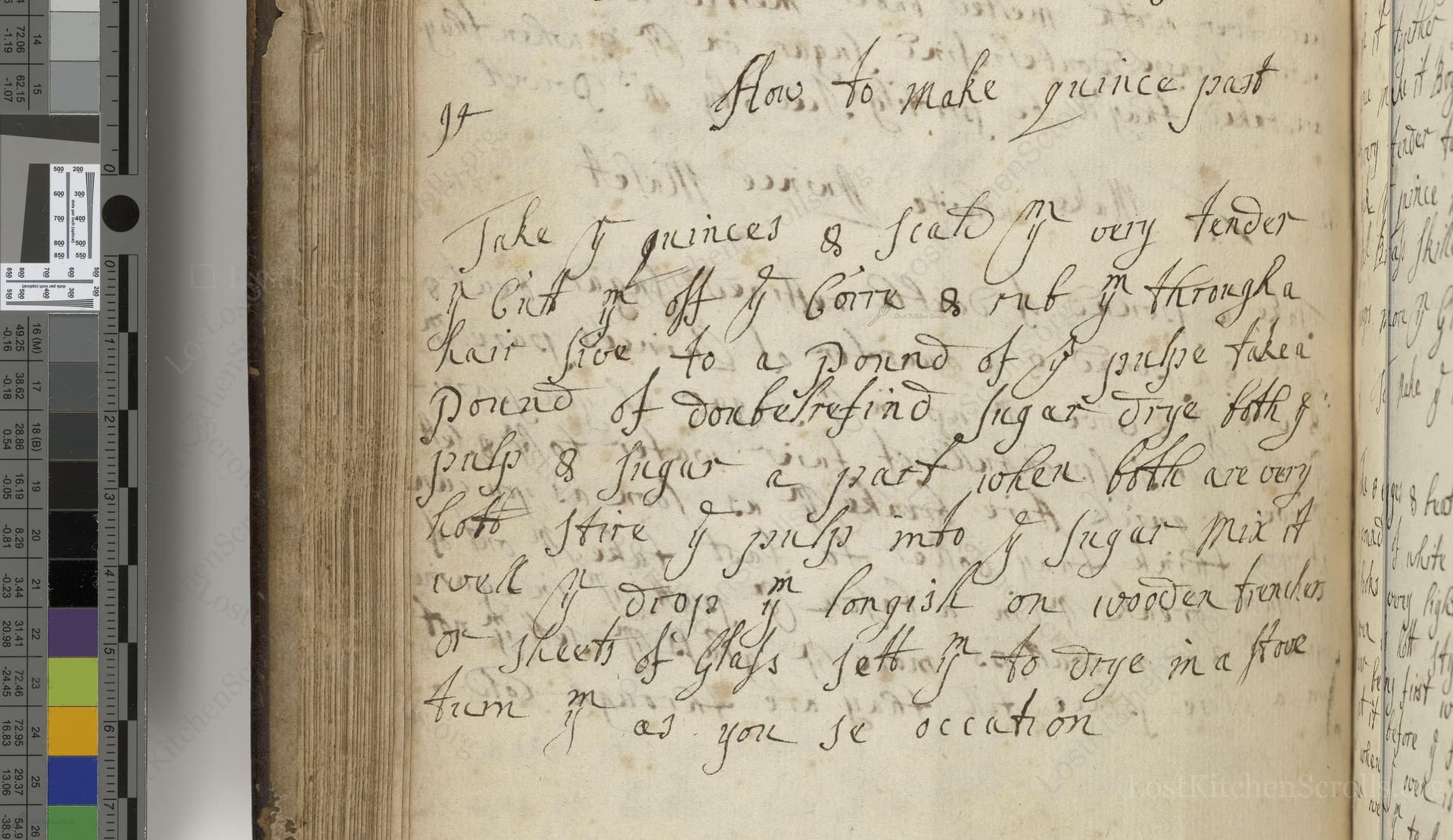How To Make Quince Past
From the treasured pages of Receipt book
Unknown Author

How To Make Quince Past
"Take ye quinces & seald them very tender & cut them off ye coare & rub them through a haire sive to a Pound of ye pulpe take a Pound of double refind sugar drye both & seeth & sugar a part when both are very hott stire ye pulp into ye sugar mix it well & drop it longish on wooden trencher or sheets of glass sett it to drye in a stove then use as you se occation."
Note on the Original Text
This recipe is characteristic of early English manuscript cookery: punctuation is sparse and spelling is variable ('ye' for 'the', 'seald' for 'simmered' or 'cooked until soft'). Instructions are assumed knowledge; quantities relate pulp and sugar by weight, and details like oven temperature or drying times are left to the cook's judgment. The method relies on tactile cues (when both mixtures are 'very hott') and on traditional kitchen tools such as the sieve. The playful, flowing spellings ('refind' for 'refined') remind us of a time before widespread spelling standardization.

Title
Receipt book (1700)
You can also click the book image above to peruse the original tome
Writer
Unknown
Era
1700
Publisher
Unknown
Background
Step back into the bustling kitchens of the 18th century, where this delightful collection offers a taste of bygone feasts, whimsical recipes, and the art of refined entertaining.
Kindly made available by
Folger Shakespeare Library
This recipe hails from the early 18th century, a period when preserving fruit in sugar was both a necessity and a luxury. Quince paste, also known as 'membrillo' in Spanish cuisine, was popular at English and European tables, often served with cheese or as a sweetmeat. The instruction manuscript comes from the 1700s, a time when recipes were handwritten collections passed down through families and adapted seasonally with available fruits.

Cooks of the day would have used a sharp knife for peeling and coring, a stout stewpot to simmer the quinces, and a 'hair sieve'—a very fine mesh strainer made from horsehair—for pressing the fruit into a velvet-smooth pulp. Sugar would be dried and heated in copper or heavy iron pans. The final mixture was often shaped on wooden trenchers (flat serving boards) or sheets of glass for drying, and set in a 'stove'—a warm drying chamber, sometimes simply near the hearth.
Prep Time
20 mins
Cook Time
40 mins
Servings
12
We've done our best to adapt this historical recipe for modern kitchens, but some details may still need refinement. We warmly welcome feedback from fellow cooks and culinary historians — your insights support the entire community!
Ingredients
- Quinces (fresh, about 2 pounds for 1 pound pulp after preparation)
- Sugar, caster or superfine (1 pound per 1 pound quince pulp)
- Water, as needed for cooking quinces
Instructions
- Begin by peeling and coring quinces—these aromatic fruits will need to be cooked until very soft.
- Quarter and simmer them gently in water until completely tender.
- Once cooked, drain and press the fruit through a fine sieve or food mill to create a smooth purée.
- For every 1 pound of quince pulp, measure out 1 pound of caster (superfine) sugar.
- Separate the sugar from the pulp.
- Gently heat both: place the sugar in a clean pan and warm just until it is hot (do not caramelize); separately, warm the quince pulp.
- When both are very hot, stir the hot pulp into the sugar and mix thoroughly.
- Drop spoonfuls of the thick mixture in longish shapes onto a sheet of baking paper set atop a wooden board or glass tray.
- Allow the pieces to dry in a warm spot—such as an oven set to low with the door ajar, or a dehydrator—until firm and translucent.
- Once dried, store in an airtight container and enjoy as needed.
Estimated Calories
120 per serving
Cooking Estimates
Peeling, coring, and preparing quinces takes about 20 minutes. Cooking the fruit until soft will take around 40 minutes. Mixing with sugar and drying the pieces will take extra time, but most of it is hands-off while the fruit dries. Each serving contains sugar and fruit, so expect around 120 calories per piece. This recipe makes about 12 pieces.
As noted above, we have made our best effort to translate and adapt this historical recipe for modern kitchens, taking into account ingredients nowadays, cooking techniques, measurements, and so on. However, historical recipes often contain assumptions that require interpretation.
We'd love for anyone to help improve these adaptations. Community contributions are highly welcome. If you have suggestions, corrections, or cooking tips based on your experience with this recipe, please share them below.
Join the Discussion
Rate This Recipe
Dietary Preference
Main Ingredients

Den Bockfisch In Einer Fleisch Suppen Zu Kochen
This recipe hails from a German manuscript cookbook compiled in 1696, a time whe...

Die Grieß Nudlen Zumachen
This recipe comes from a rather mysterious manuscript cookbook, penned anonymous...

Ein Boudain
This recipe comes from an anonymous German-language manuscript cookbook from 169...

Ein Gesaltzen Citroni
This recipe, dating from 1696, comes from an extensive anonymous German cookbook...
Browse our complete collection of time-honored recipes



